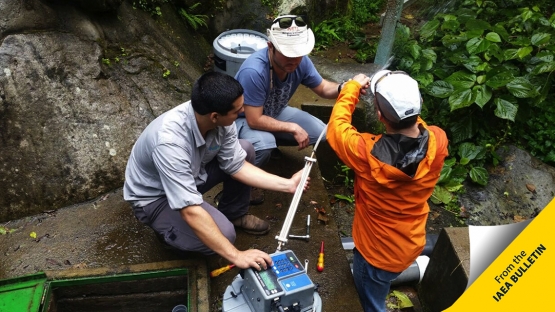Sitting on the thin stretch of land that separates the Pacific from the Caribbean, Costa Rica has in recent years experienced above-average ocean temperatures and the first hurricane ever recorded. With the help of the IAEA, its scientists are now turning to isotopic techniques to monitor these extreme weather events and protect the country’s water and population, in a region that has been identified as an area that could be particularly affected by climate change.
“Water has memory,” said Ricardo Sánchez-Murillo, coordinator of the Stable Isotopes Research Group at the National University of Costa Rica in Heredia. “With isotopes, we can record this memory and use the current information we gather in precipitation to understand past climate events and improve Costa Rica’s planning to face future meteorological events, including hurricanes.” In 2015, after a severe drought period, Central America saw one of the strongest El Niño Southern Oscillations — a warming of the ocean surface that has been happening in the region for centuries. One year later, Costa Rica faced the first hurricane recorded to date in the southernmost region of Central America.
“We didn’t have any historical records of hurricanes impacting Costa Rica,” SánchezMurillo said. “So we were susceptible and suffered the consequences, because we didn’t know how to respond.”
Such phenomena carry with them a collection of isotopic fingerprints that scientists like Sánchez-Murillo can capture using special nuclear-derived techniques. Once recorded, they use the isotope data, coupled with climatic models and past climatic records, to predict the frequency, magnitude and intensity of future meteorological events and inform authorities, who in turn can be better prepared. The science behind this is called isotope hydrology (see Isotope hydrology).
“We now have the tracers, which act as a sentinel,” Sánchez-Murillo said. “These techniques give us the capacity to see what conventional instruments cannot reach. Where conventional methods cannot see, isotopes can.”
Using isotopic techniques to study poorly understood water systems, experts are also finding solutions to water challenges related to climate change that are affecting even the wettest regions, including Costa Rica. With these techniques, scientists can determine the quantity and quality of water supplies. They use naturally occurring isotopes as tracers to find out where groundwater comes from, if it is recent or old, if it is being recharged or polluted, and how it travels.
While we have always had regulations in place to protect our water, the difference is that now we can be more precise, more efficient .







